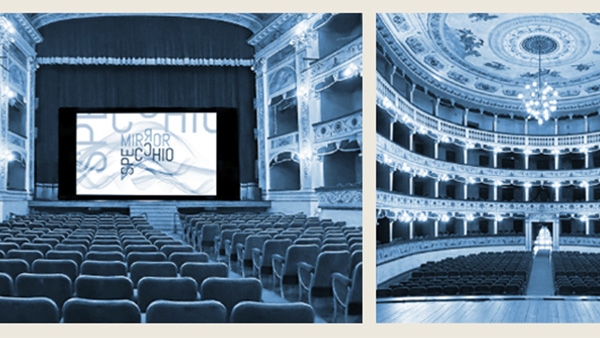The Mirror project, under the
coverage of Agrigento Capitale Italiana della Cultura 2025, realised in collaboration with The Atlas (of Creative Mechanisms):
[Curating–Conducting]. From both a conceptual and structural perspective, the project adopts an experimental framework, reimagining
the traditional space of an opera house through the lens of contemporary art. Works (based on moving image), which either
process or incorporate musical components, sound, rhythm, and performative structures, are presented in the format of screenings
in lieu of an opera, ballet, or concert. Simultaneously, photographs are exhibited on the stage itself, utilising the theatre’s
mechanical systems in the form of an exhibition.
By inviting the audience to step onto the stage and experience
it as an exhibition space, The Mirror challenges conventional modes of spectatorship and transforms the performative setting
into an immersive visual and spatial encounter. This recontextualisation of the operatic environment opens up new perceptual
and conceptual possibilities to reflect on the shifting boundaries between artistic disciplines.
These spatial,
perceptual, and sensory interventions will be further explored through a critical and reflexive exchange between the curators
and documented in the forthcoming Atlas publication.
THE PROJECT
The
“Mirror” project consists of three interconnected chapters. The first chapter is the experimental exhibition held on the stage
of Teatro Pirandello in Agrigento. It combines a film screening with photographs, inviting the audience to step onto the stage
to experience the photographs in a unique exhibition setup and watch the films as opera audiences. The second chapter is a
book that mirrors art and the city of Agrigento. It processes observations through the eyes of a stray cat hovering around
the city. The third chapter entails the dissemination of the film programme and the book to partner institutions in different
cities across Europe: Istanbul Modern (Istanbul), Kunsthalle Wien (Vienna), Kunsthaus Dahlem (Berlin), Liljevalchs Konsthall
(Stockholm), National Museum of Modern Art (Zagreb), The Art Rooms, ARUCAD (Kyrenia) and CVAR Centre of Visual Arts
and Research (Nicosia); Cyprus, The Reykjanes Art Museum (Reykjavik).
The participating artists of the project are
Ali Cherri (LB/FR), Almagul Menlibeyeva (KZ/DE), Cristiana de Marchi (IT/LB/AE), Egle Oddo (IT/FI), Emilija Škarnulytė ( (LT),
Francesco Bellina (IT), Hera Büyüktasciyan (TR), Herrana Addisu (ET), Icelandic Love Corporation (IS), Isa Rosenberger (AT),
Jesper Just (DE), Johan Thom (ZA), Larissa Sansour (PS/UK) – Søren Lind (DK/UK), Marcus Neustetter (AT), Marja Helander (FI),
The ZoNE (AT), Maria Lantz (SE), Nisrine Boukhari (SY/AT), Oya Silbery (CY), Rojda Tugrul (TR/AT), Ramesch Daha (AT), Superflex
(DK), Theresa Traore Dahlberg (SE), Wael Shawky (EG), and William Kentridge (ZA).
Most of the editions of the photographs
were produced in Agrigento and donated to the Agrigento City Museum upon the conclusion of the exhibition at Teatro Pirandello,
Agrigento.
THEME
Agrigento, designated as the Italian Capital of Culture
for 2025 (Agrigento Capitale Italiana della Cultura 2025), has structured its programme around four thematic elements: Air,
Earth, Water, and Fire. The “Mirror” project is presented under the theme of ‘Water’.
The Mediterranean region has
always generated and orchestrated a unique understanding of imagination through unexpected associative processes, especially
through the theme of water as an overarching motif. The project operates as an analogy to observing a broken mirror with its
fragments. In this context, the main curatorial objective of the project is to incorporate the mirroring of various elements
to one another: the city of Agrigento, the element of water, films, photographs, music, and the audience creating a strong
and unified experience at Teatro Pirandello Agrigento, with a scheduled program spanning a month. This experience will also
be captured in a book that reflects and intertwines these elements, narrated through the perspective of a stray cat named
‘Surfaro’.
The Atlas (of Creative Mechanisms): [Curating–Conducting]
is a PEEK project led by Assoc. Prof. Dr. Basak Senova, with interdisciplinary input from key researcher Dr. David Chisholm,
funded by the Austrian Science Fund (FWF) and hosted by the Institute of Art Sciences and Art Education at the University
of Applied Arts Vienna.
Doi: 10.55776/AR721




